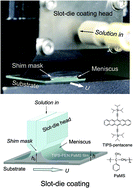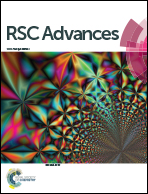Organic thin-film transistors fabricated using a slot-die-coating process and related sensing applications
Abstract
We herein present the results of a study involving the fabrication of semiconductor thin films for organic thin-film transistors (OTFTs) composed of a small molecular 6,13-bis(triisopropylsilylethynyl)-pentacene (TIPS-PEN) composite blended with a polymer binder of poly(α-methylstyrene) (PaMS), i.e., TIPS-PEN:PaMS. Thin TIPS-PEN:PaMS semiconducting films were effectively produced using a simple slot-die-coating process operating in a dip-coating mode. It is shown that the slot-die-coating process used here allows critical control of the thickness of the TIPS-PEN:PaMS film; nanoscale thin films could be produced using the downstream meniscus of the blended solution at speeds of the order of a few meters per minute. It is also shown that the slot-die-coated TIPS-PEN:PaMS OTFTs exhibited maximum field-effect mobility of 0.33 cm2 V−1 s−1 and on/off ratios which exceeded 105, both of which are superior to those of conventional spin-cast devices. We also provide an example of an application of the slot-die-coated OTFTs to demonstrate that the OTFTs investigated here can be used to operate a protein sensor device. Considering these results, we believe that the slot-die-coating method with the blended composite of TIPS-PEN:PaMS shows considerable promise for the high-throughput production of reliable, reproducible, and high-performance OTFTs.


 Please wait while we load your content...
Please wait while we load your content...